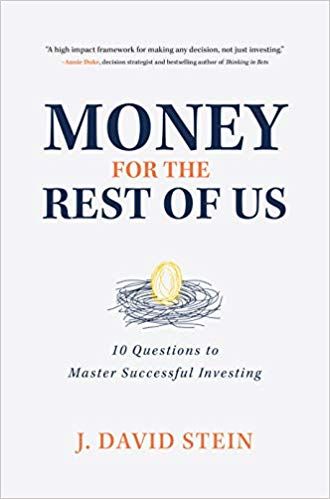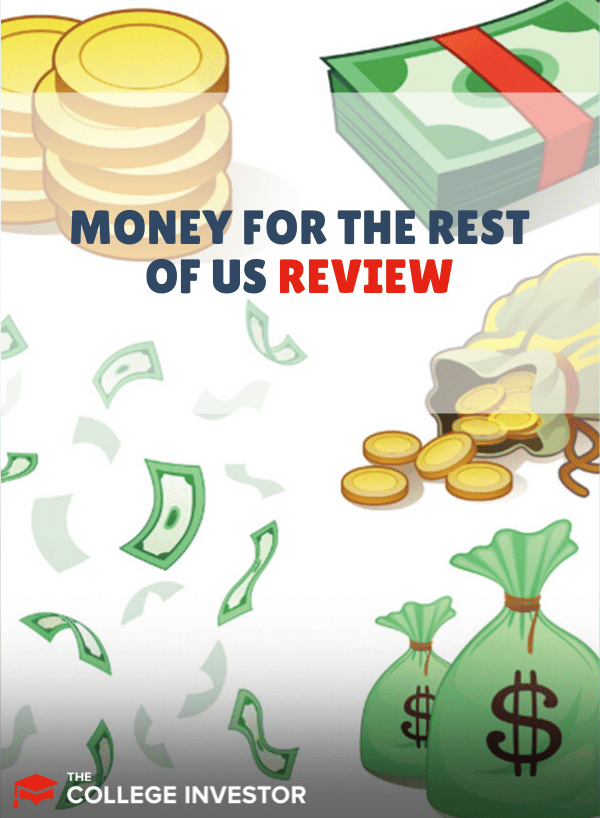
Author J. David Stein educates and inspires his readers with Money for the Rest of Us, informing them that they needn’t be experts to excel at investing.
The goal of Stein’s book is to encourage readers to step back and analyze investment opportunities, by using his 10-question framework to increase the odds of succeeding at investing.
Overall Summary
Through pragmatic moves and sound advice, Money for the Rest of Us is a guide to sidestep many of the common and costly investing mistakes. Even for those already focused and disciplined in saving for retirement, Stein reiterates the importance of navigating the complex matters of investing with rules of thumb to further grow wealth.
Stein presents the material in a straightforward way that works for both beginners and more seasoned investors alike. The book is very approachable, with Stein regularly offering up examples of what not to do, as a way to keep this investment book grounded and authentic.
Chapter Summary
Chapter 1: What Is It?
When just starting out as an investment strategist, Stein explained how naivety and a lack of understanding undermined his portfolio goals.
As a result of his early experiences, he created the 10-question roadmap. The thought behind it is that by slowing down and putting in the due diligence necessary, readers will have a better chance at making solid investment choices.
Stein puts it this way: If you are unable to explain an investment to a family member or friend in a way that the person can understand, then you shouldn’t invest. It is such a simple rule to understand and follow, and one that could save millions of investors from overstepping and acting too quickly when investing.
By better understanding the math and very real emotions surrounding the investment process, an investor will be in a stronger position to make better choices and decisions.
Chapter 2: Is It Investing, Speculating, or Gambling?
Stein explains how investing in things like real estate and stocks involve a cash flow component, and have positive expected returns. Given the high likelihood of turning a profit, investments should represent 90% of a portfolio.
Speculations, on the other hand, are assets where the outcome is highly unpredictable, and there is viable disagreement as to where the price will land in the end. So think gold and oil, or art and collectibles. Stein recommends holding no more than 10% of one’s portfolio in speculations, with 90% or more in investments.
Gambling should not be counted on for any expected returns, and Stein says it should only be considered for sheer entertainment value. Given that the odds are stacked against any investor that moves forward with a gamble, there should be no assumption of gain or profit. Stein reiterates the importance that an investment discipline of answering specific questions has on ensuring we are not gambling due to our lack of knowledge.
Chapter 3: What Is the Upside?
Stein explains that using historical returns to estimate expected returns from an asset class is dangerous, given that the circumstances are always changing.
Stein stresses the importance of using rules of thumb to determine an investment’s expected return. These simple patterns that everyone can follow without the need of expertise are based on cash flow, cash flow growth, and the potential change in what investors pay for the cash flow in the future.
He explains how when an individual stock generates an extremely high return, it is because the cash flow increased rapidly or investors were willing to pay much more for existing cash flow. Whereas, a diversified basket of stocks will rarely exceed double-digits over the long term because the cash flow can’t exceed the growth rate of the overall economy.
The risk of bonds due to the fluctuating interest rates in both the short and intermediate terms, with a greater price decline as interest rates rise, is also covered. So is applying common sense via the rules of thumb for estimating investment returns, as a way to avoid the pitfalls of chasing fad investment opportunities.
Chapter 4: What Is the Down Side?
Stein covers volatility in simple and straightforward terms in Money for the Rest of Us. Given what is at stake for an investor, understanding the measures that can gauge how a security or asset class deviates from its expected or average return is critical. The greater the volatility, the greater the likelihood the investment will lose money moving forward.
Stein explains that volatility tends to cluster, with periods of relative calm in the financial markets, followed by waves of turbulence. So while it is impossible to avoid losses at all costs, the focus when evaluating an investment’s downside should be in avoiding irreparable financial harm.
Money for the Rest of Us encourages investors to keep an objective approach to determining an investment’s downside. Looking at historic declines, as well as how long an investment took to recoup its value, needs to be weighed and balanced. And of course, changes in interest rates and economic growth prospects also need to be taken into serious consideration regarding market volatility.
Chapter 5: Who Is on the Other Side of the Trade?
Stein dives deep into the importance of identifying counterparty risk by answering the very important question of, “Who is on the other side of the trade?”
Stein also explains the ins and outs of portfolio and risk management, and how actively allocating to the most compelling areas of the market in terms of the expected return and valuation works.
Chapter 6: What Is the Investment Vehicle?
An investment vehicle is a product that is used to bring positive returns. Some examples of investment vehicles include individual stocks, bonds, real estate, and mutual funds.
Stein explains that the attributes of an investment vehicle include the expected return and risk of the financial move. Investment vehicles can be low-risk like with bonds, or they can carry a higher risk — think stocks.
Chapter 7: What Does It Take to Be Successful?
According to Stein, the best way to see the bigger picture of our investment strategy is by using rules of thumb. This offers a broader view of the various investment opportunities with regard to their potential return, risk, and return drivers. He adds that return drivers explain why investments have positive expected returns.
The simplest way to harvest those returns, according to Stein, is through the use of mutual funds or ETFs.
Stein explains how an investment’s outcome is determined by the underlying drivers of performance. He says investors should look to dependable return drivers, such as income, cash flow growth, individual effort, and investments bought at attractive prices. By allocating most of one’s capital to investments with dependable return drivers, the odds of successful outcomes increase.
Chapter 8: Who Is Getting a Cut?
Money for the Rest of Us breaks down the basics of investment expenses, and explains the fees involved with trading costs, as well as advisory and administrative fees.
Stein points out that given how the fees cut into an investor’s returns, it is important to make sure that the benefits received are worth it. And if the benefits are not worth the fees, he says there are always lower-cost options available.
He also makes clear that a good financial advisor will provide perspective and collaborate with you — so important, given that you are making decisions that will impact your future financial growth. A trustworthy and ethical advisor will be upfront on their fees, and will not promise things they can’t deliver — like a promise to outperform the market.
Chapter 9: How Does It Impact Your Portfolio?
Stein stresses the importance of making portfolio decisions based on the kind of financial harm that an extreme event would have on your lifestyle. Paying attention to what a major decline in the stock market would do to the security of your family’s well-being is far more critical than the gains an investment may make in the end.
Individual investors should rely on the rules of thumb, and not fixate on arriving at the perfect investment picks for a portfolio. Instead, focus on diversification with a base of mixed stocks and cash — because they will react differently to the same economic event, therefore bringing a level of stability.
Chapter 10: Should You Invest?
The 10-question framework informs and encourages analysis of different investment strategies, so that by the end of the book, Stein hopes that his readers have clarity about what to do. The reality is that by the last chapter, the reader should be well on their way to a better understanding of how to analyze the many aspects of investing.
Stein covers dollar-cost averaging and how to invest a large sum — like an inheritance, bonus, or buyout. He also stresses the importance of considering the expected upside (like its ability to exceed the rate of inflation) as well as the downside of an investment.
Socially responsible investing — that is, making investment decisions based on your moral or ethical values — is discussed, with Stein explaining the importance of making sure a new investment aligns with your personal values.
About the Author
J. David Stein is an author as well as the host of the personal finance podcast, Money For the Rest of Us. Prior to launching his podcast, Stein advised and managed assets for institutions and planners.
He was the chief investment strategist and the chief portfolio strategist at Fund Evaluation Group, LLC, an investment advisory firm of $70 billion, where he co-headed the 21-person research group. He also co-founded the firm’s asset management division of $2.2 billion, where he developed its investment philosophy and process, and was the lead portfolio manager.
Stein served numerous not-for-profit institutions, where he assisted the boards and staff in overseeing billions of dollars in endowment assets.
Final Thoughts
Money for the Rest of Us really drives home the importance of taking a step back to analyze and assess all aspects of an opportunity before deciding to move forward with an investment.
Stein keeps things real, and does a great job of explaining the many lessons he learned over a lifetime of investing.
By simplifying the all-important first steps, and walking his readers through different financial scenarios and examples, he makes the 10-question framework both approachable and manageable.
Like this book review? Check out some other top reads:
Money For The Rest Of Us Book Review
-
Easy To Read
-
Useful or Helpful
-
Story Telling
Overall

Teresa Stack Hunter is a freelance writer with two decades of journalistic expertise, and earned dozens of bylines with Thrive Global, The Reston Times, The Washington Citizen and The Kent County News. Teresa also worked as a writer-editor for The Department of Treasury, where she had the great honor of serving Under Secretary of Enforcement Ronald K. Noble, and his equally impressive replacement, Under Secretary of Enforcement Raymond W. Kelly. She holds a B.A. in Communications from Marymount University.
Editor: Clint Proctor Reviewed by: Robert Farrington

